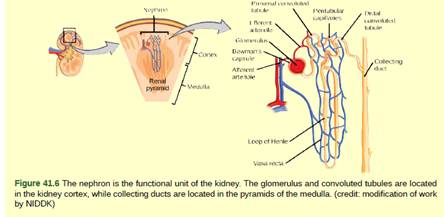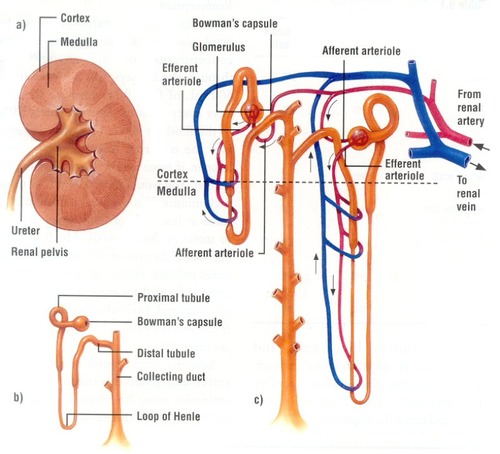Which of the Following Structures Drains Into the Collecting Duct
Which of the following represents in order the path of a blood cell passing through the kidney. Lumbar duct and left lymphatic duct.

Chapter 24 Urinary System Ppt Download
Afferent arteriole glomerulus glomerular capsule collecting duct.

. From collecting ducts urine drains into the minor. Peritubular capillaries glomerulus afferent arteriole renal vein b. Drop each label into the appropriate box.
Following the PCT the loop of Henle a hairpin-like structure penetrates the medulla and returns to the cortex to connect with the distal convoluted tubule DCT. An average of six nephrons drains into a collecting duct. The sequence of structures that urea passes through in the nephron is.
The funnel-shaped structure that receives urine from collecting ducts and drains it into the ureter ___ Nephrons that have long loops that extend deep into the renal medulla ___ Structure which receives excretory fluid from proximal convoluted tubules and transports it to distal convoluted tubules ___ Blood flows from glomerulus to proximal tubules and then to ___. It acts on the blood forming tissue of the spleen. Correctly indicate the collecting duct that drains each area.
It acts on the blood-forming tissue of the spleen D. All of the above. Distal convoluted tubule Which structure is included in the discussion of the urinary system even though is it part of the circulatory system.
Collecting ducts descend through the cortex and medulla and successively fuse near the inner medullary region. This figure shows the areas of lymphatic drainage. A nephron is composed of the Bowmans capsule the proximal tubule the loop of the nephron called the loop of Henle the.
Label the components of the sectioned lymph node. It is secreted by the kidneys B. Indicate the correct order of vessels.
Renal corpuscle B loop of Henle C. From collecting ducts urine drains into the minor calyces which join to become major calyces that unite to form the re- nal pelvis see Figure 263. Finally the nephron drains into the collecting duct via connecting tubules.
Filtrate in the proximal convoluted tubule normally contains. Following the PCT the loop of Henle a hairpin-like structure penetrates the medulla and returns to the cortex to connect with the distal convoluted tubule DCT. From the renal pelvis urine first drains into the ureters and then into the urinary bladder.
After being filtered by lymph nodes lymph flowing through lymphatic collecting vessels drains directly into. It stimulates the formation of RBC C. Toward the papillary tip converging papillary ducts form approximately 20.
Finally the nephron drains into the collecting duct via connecting tubules. Intestinal duct and left intercostal duct. Asked Oct 18 2021 in Anatomy Physiology by Reckless.
All parts of the kidney. Which of the following structures drains into the collecting duct. Bronchomediastinal duct and subclavian duct.
Consider each area of the body and the destination of its lymphatic drainage. Thoracic duct and right lymphatic duct. Urine is then discharged from the body through the single urethra see Figure 261.

Figure 41 6 Which Of The Following Statements About The Nephron Is False The Collecting Duct Empties Into The Distal Convoluted Tubule The Bowman S Capsule Surrounds The Glomerulus The Loop Of Henle Is

Structure Of A Nephron And Collecting Duct The Neighbouring Blood Vessels Associated With A Nephron Flashcards Quizlet

Comments
Post a Comment